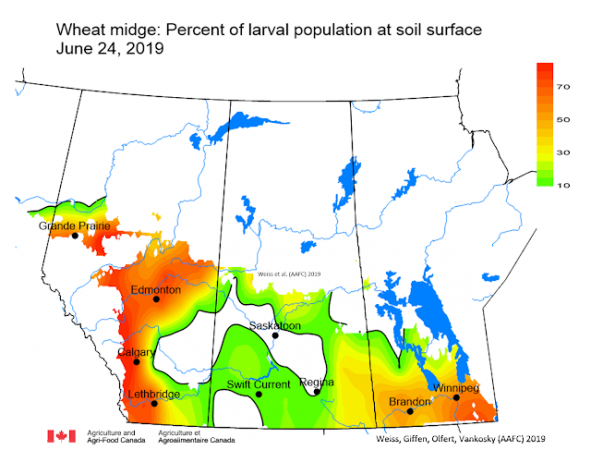
News
Insect Pests
Prairie producers on the lookout for bertha armyworm and wheat midge
June 26, 2019 By Top Crop Manager
Crop pests, such as bertha armyworm and wheat midge, are on producers’ radars across the Prairies.
As of June 24, 2019, bertha armyworm adults are emerging across the Prairies, according to the latest from the Prairie Pest Monitoring Network (PPMN). In the southern regions, bertha armyworm populations are predicted to be at the egg stage.
The PPMN reminds producers that the bertha armyworm can sometimes be confused for its doppelgänger, the clover cutworm, so producers are encouraged to review bertha armyworm information within the “Field Crop and Forage Pests and their Natural Enemies in Western Canada: Identification and management field guide.”
Wheat midge adults generally emerge during the first week of July, but dry conditions reduce or delay wheat midge emergence.
The PPMN compared weather data to long term normal values and found that May and June temperatures in the Saskatoon region have been one degree celsius cooler and rainfall has been 40 to 60 per cent less than normal. The recent dry conditions can have a significant impact on wheat midge emergence by delaying the movement of larvae to the soil surface.
Research models out of Agriculture and Agri-Food Canada (AAFC) Saskatoon from 2016 showed that dry conditions may result in delayed adult emergence and a reduced number of adults and eggs.
As of June 24, according to the latest from the Prairie Pest Monitoring Network, 29 per cent of the wheat midge population is predicted to have moved to the soil surface. Weeks prior, as of June 17, only 18 per cent of the wheat midge population was at the soil surface. Areas along the Edmonton to Lethbridge corridor within Alberta, and southeast of Winnipeg, show the highest percentage of larval population on the soil surface.

Percent of wheat midge larval population at the soil surface (as of June 24, 2019) across the Canadian Prairies. Map courtesy of AAFC.
Adequate rain in Alberta and Manitoba should have resulted in movement of larvae to the soil surface, while dry conditions in Saskatchewan have delayed the development of larval cocoons. However, recent rains in late June in Saskatchewan would reignite the development of larval cocoons, and therefore, the movement of larvae to the soil surface.
Despite the expectation of wheat midge, the PPMN states that wheat midge populations are expected to be low across most of Alberta and Saskatchewan based off of fall surveys in 2018.
The Prairie Pest Monitoring Network is made up of field crop entomologists who conduct research and actively monitor pests to support crop protection on the Canadian Prairies. The Network includes researchers from Agriculture and Agri-Food Canada, Manitoba Agriculture, Saskatchewan Agriculture, Alberta Agriculture and Forestry as well as university researchers.